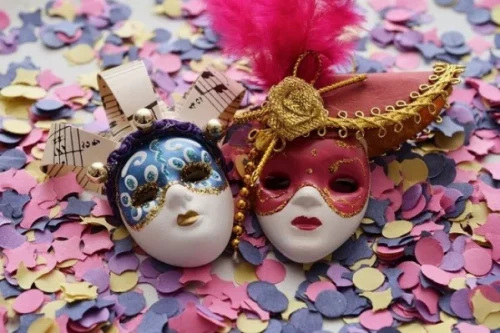Between the 16th and early 17th centuries, Barcelona’s Carnival was one of the tops in all of Europe – but all that disappeared under Franco. So, since the end of his dictatorship in 1980 people have been making up for all of those years without a carnival. Nowadays, the desire to have a good time and make merry is just as strong as it was 685 years ago.

Since 80s, the Carnaval was copied from Brazilian with a one central ‘Gran Rua’, but in 2012 this part of the celebrations was discontinued. The ambition and focus now is to create a Barcelona carnival format that takes inspiration from the ancient carnivals from previous centuries dating back to the 14th century. The 21st century carnival in Barcelona is all about participation and sharing.
What is Carnival about?
Barcelona Carnival, Mardi Gras or Carnestoltes – whatever you may choose to call it – marks the last time for mischief, over-indulgence and an excuse for a serious party before the purging of vices and the start of some dedicated abstinence during Lent (Quaresma). It is the time of joy, exuberance and joie de vivre, before Ash Wednesday when the 46-day Lent to Easter begins.
How does it celebrate?
The carnival begins with “Dijous Gras” or “Dijous Llarder”, which means Fat or Greasy Thursday, the first day of the Carnival cycle, when the King of Carnival (Carnestoltes) makes his triumphant entrance into Barcelona to proclaim his reign of revelry. This calls ‘l’Arribo’ (The Arrival), the central event of the Barcelona Carnival festivities. The symbolic role of the Carnival King is to carry all the sins of power, and take responsibility for all the bad things that occurred throughout the year.

King is surrounded by his splendid Court: the Prime Minister, the Seven Ambassadors, who represent the seven historical villas of the city- Magòria, Sol de Baix, Tres Torres, Camp d’en Grassot, the Horta laundries, Sant Genís dels Agudells, Fabra i Coats and Clot de la Mel, their attachés, musicians, flag bearers, the Barcelona Carnival giants Rodanxó and Rodanxona and more revellers.
Traditional food
As the traditional reason for Carnival is to eat as much as possible before the Lent begins, food-oriented events are organised throughout this day in most of the local markets and bars. The typical Catalan Carnival foods are botifarra d’ou (egg pork sausage), truites (omelette), coca de llardons (flat pastry cake made with eggs, sugar, pork crackling (llardons) and pine nuts) and escudelles (thick meat soup).

As there is no more central parade in Barcelona, the following weekend you can find many local events and local carnival parades all over the city. The main event of Sunday is “La Taronjada” – a colourful battle between the Carnival players and the public of orange balloons and confetti, recalling the actual oranges that were once thrown as far back as the 14th century.
Burial of the Sardina
The week of the celebrations ends on “Dimecres de Cendra” or Ash Wednesday. Throughout the world, Ash Wednesday is a date known by Christians to fall forty working days before Easter Sunday. It symbolises the start of Lent – a period of forty days in the run up to Easter in which Christians have traditionally shown abstinence from their vices, whatever they may be. This day the carnival comes to an end with the Funeral of the Sardine. There are several explanation of this peculiar tradition, one maintains that a group of students who, meeting in a back room of a chemist’s in Madrid in the 19th century, decided to hold a satirical funeral march for the fish symbolising abstinence and fasting.

The “Burials” generally consist of a carnival parade that parodies a funeral procession – the colourful costumes are appropriately exchanged to black mourning clothes – and culminates with the burning of a symbolic figure, usually a representation of a sardine. This symbolical burial of the past to allow society to be reborn, transformed and with new vigour.
Many community meals are held on this day in different neighbourhoods and emblematic parts of Barcelona, where everyone is invited to eat sardines and herrings with a loaf of rustic bread and a good glass of wine.
Carnaval of Sitges

To see more extravagant and colourful carnaval parades you should head to Sitges, which is a popular seaside resort town just 35 km south of Barcelona, where the Sitges Carnival is celebrated on the same days as Barcelona. It is famous for its flamboyant parades, thanks to a fantastic annual effort by Sitges residents.




